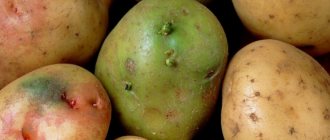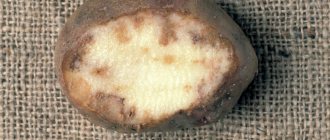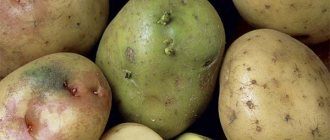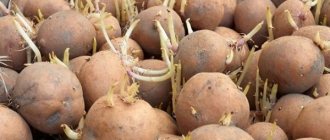Why do peeled potatoes darken and lose their taste?
Tubers always darken after cleaning. This happens for the following reasons:
- Raw potatoes contain sugar (about 0.9%). When interacting with amino acids (enzymes), they are destroyed, and a change in organoleptic properties occurs: taste, color, smell. Therefore, the less sugar in the tubers, the longer the potatoes will be stored.
- Potatoes also contain microelements - iron, calcium, magnesium, potassium, sodium, etc. When they interact with oxygen, an oxidation reaction occurs, the product gradually turns black and loses its taste. If you block the access of oxygen, the process slows down.
There are several ways to slow down blackening and deterioration. Some of them are acceptable only in large industries, while others can be used in a regular kitchen.
Find out how to store potato supplies in winter in a cellar, apartment, or in the ground.
Why do potatoes turn black after cooking?
There are several possible reasons why boiled potatoes turn black or blue, the most common among them are the following:
- Modern agricultural practices for industrial cultivation (for sale) of this crop may include the use of large amounts of chlorine. This element helps to increase the weight of the tuber, although it negatively affects its structure: the pulp becomes watery, which is why it can darken during heat treatment.
- The use of nitrogen-containing fertilizers provokes the formation and accumulation of amino acids in the tuber, which can cause spots that are invisible in raw potatoes, but appear in boiled ones.
- Tubers that have been frozen can change color. Under the influence of negative temperatures, starch breaks down and a monosaccharide is formed - glucose, which imparts sweetness and is the cause of color change during heat treatment.
- A possible cause may be injuries sustained during transportation. When the tubers hit a hard surface, indentations are formed at the contact points, from which starch-rich potato juice is released. And this polysaccharide, in turn, forms dark spots when oxidized.
- Another factor that can cause blackening may be improper preparation for storage. After the crop is harvested (this should be done in dry weather), it must be thoroughly dried in air, the remaining soil must be removed, sorted out, and spoiled and rotten tubers must be discarded.
- Non-compliance with storage requirements (relative humidity and low oxygen concentration in the air are exceeded).
- Starch-rich varieties are more susceptible to blackening during heat treatment.
Methods for storing peeled potatoes in production
Since potatoes are one of the staple foods, they are used in large quantities for the production of semi-finished products. Because of this, the issue of storing the purified product is very relevant.
If there is a significant amount of vegetables, special methods are needed:
- Treatment with special substances, one of which is sodium bisulfite. This compound keeps enzymes from being destroyed. After processing, potato tubers do not lose their color and are no different from those that have just been peeled. With this method of preservation, the vegetable is stored for about 2 days at a temperature of about 7 °C. Before cooking, potatoes should be washed thoroughly, changing the water several times.
- Storage in a modified gas environment. Food bags are filled with vegetables, oxygen is pumped out of them, and instead the bags are filled with a mixture of nitrogen and carbon dioxide. The special gas composition prevents the growth of bacteria that destroy the taste and color of the product. Shelf life at 3 °C is about 20 days.
- Use of vacuum packaging. The air is pumped out of the bags with a vacuum pump after they are filled with peeled potatoes. This method slows down the oxidative reaction of substances found in vegetables. Shelf life at 3 °C is about 18 days.
The main thing when storing peeled potatoes is to avoid contact with oxygen by any means.
For catering plants, restaurants, schools, such forms of saving peeled vegetables are convenient. They are not cheap, so they cannot justify themselves in everyday life.
When cooking at home, it is not possible to use production methods. And it doesn’t make sense to keep the product for so long. Therefore, housewives have different ways of storing peeled potatoes.
In a refrigerator
Peeled potatoes can be stored until the next morning in the refrigerator compartment. The air temperature inside household appliances should not exceed +6 ℃.
Regarding what treats the vegetable will be used for, you can keep the product in the refrigerator compartment using various methods:
- Root vegetables can be placed in a container with cool liquid and placed inside household appliances. This option is considered simpler and allows you to use the tubers for preparing various delicacies.
- The vegetable can be blanched. To do this, whole root vegetables must be immersed in a container with very hot liquid for a few seconds, then distributed into bags and placed in the refrigerator compartment. Hot water helps destroy the enzymes contained in the top layer of potatoes. As a result, they will not be able to come into contact with oxygen. Unlike a fresh product, blanched vegetables can be stored for a long period of time. However, it has a specific flavor and is suitable for cooking whole.
- Peeled potato tubers can be kept in a tightly tied bag. You will need to completely bleed the air out of it first. After this storage method, the product is suitable for preparing various treats.
- Peeled root vegetables can be chopped on a shredder, supplemented with chopped garlic cloves and onions. The composition must be transferred to a container and covered with cling film on top. It is recommended to store the workpiece in the refrigerator compartment and use it for preparing products from grated vegetables.
How to store peeled potatoes at home
There are several ways to preserve taste, color, and usefulness in vegetables after cleaning at home. They are quite well known and simple:
- Cold water. You can place the peeled tubers in cold water. But in this way the vegetable will be stored for no more than 4 hours. This is due to the fact that peeled potatoes lose useful substances in water: organic acids, microelements, vitamins.
- Food bags. After peeling and washing the potatoes, place them in a plastic bag and squeeze out as much air as possible. Place the bag in the refrigerator. This method will preserve the product for a day.
- Freezing. Place the peeled vegetable in a plastic bag in the freezer. If the preparation is intended for soup or frying, the tubers should be cut accordingly before freezing.
- Boiling water. Scald the finished semi-finished product with boiling water. The top layer of each potato will be protected from browning by high temperature treatment. This product can be stored in the refrigerator for no more than a day.
Tip of the day
Place the container with water and potatoes in the refrigerator - the storage time will increase to 24 hours.
scalding
You can preserve peeled potatoes in the open air for 6 hours by scalding them with a very hot liquid. Thanks to this method, the shelf life of root crops increases. At the same time, they will not deteriorate and darken at room temperature.
Until the next cooking, the tubers will not spoil, but the taste will change slightly. The product must be stored in the refrigerator compartment, first immersed in cold liquid. In this case, potatoes must be kept in a container with an airtight lid.
Storage time dictates the method
The storage time of the semi-finished product affects the choice of method. To preserve the maximum taste and nutritional properties of the product, you should follow simple rules:
- For a few hours. If the cooking time is delayed by 3-4 hours, feel free to peel the required amount of vegetable and immerse it in a bowl of cold water.
- For the night. When you plan to prepare a potato dish for breakfast, fill the peeled tubers with cold water in the evening and place in the refrigerator until the morning.
- For a day. Place the prepared product in the refrigerator using a bag or bowl of water. It is necessary to cover all the potatoes with water or first check the tightness of the bag. You can also pour boiling water over the tubers and place them in the refrigerator after cooling.
- For a long time. If you plan to store the peeled vegetable for a long time, then the freezing method is ideal. And when cooking, do not defrost it, but immediately put it in boiling water or hot fat. It is not recommended to use a microwave oven for defrosting.
At sub-zero temperatures, starch is converted to sugar, so the longer the potatoes are exposed to low temperatures, the sweeter they become
What to do to prevent potatoes from browning
Experts and experienced gardeners advise adhering to the following rules, which will prevent the root crop from changing color during the cooking process.
Choosing the right potatoes
When purchasing, it is important to carefully examine and feel the tubers. They should be firm with no signs of damage. Potatoes should be discarded if they have dents, cuts, or rotten formations. Low quality is also indicated by compressed skin and sprouted eyes. If you buy vegetables in bags for home preparation, then you should look inside them to check the dryness of the potatoes.
The appearance of dark spots after heat treatment of a vegetable can be caused by the high starch content in the pulp. When making a purchase, you should be interested in the name of the variety. Potato varieties that have a starchy texture should be avoided.
Reference! Root crops with a high starch content are classified as fodder crops. Among them: Minerva, Lorch, Voltman, Korenevsky, etc. You should not purchase such vegetables for cooking.
Fertilizer
When growing root crops yourself, it is important to monitor the composition of the fertilizers used. Preference is given to potassium-containing fertilizers. Do not overdo it with nitrogen fertilizers and chloride nutrients for the soil.
When feeding the soil with organic matter, you need to take into account that it also contains nitrogen and chlorine. Therefore, you should not violate the recommended consumption rates per 1 m2. All fertilizing is applied according to the schedule developed by agronomists for certain crops.
Storage
The harvested crop is laid out in the fresh air or under a canopy to dry. It is important that the sun's rays do not fall on the potatoes, otherwise they will quickly turn green.
Dried tubers are stored in a cool place until cold weather sets in. Further storage is carried out in a prepared winter hut (cellar, basement and other specially equipped premises). It is systematically required to control the following microclimate indicators: humidity (moderate), temperature (within 1-8°), oxygen flow (natural or forced ventilation).
How to determine the suitability of peeled potatoes
If storage conditions are not observed, peeled potatoes will spoil. This can be seen by the appearance of the tubers and the water in which they are stored:
- If the water just turns cloudy, it means starch has been released from the potatoes. This is normal.
- If a container of water is filled with air bubbles, this is a sign that the process of fermentation and breakdown of useful substances has begun.
- If the tuber becomes slippery to the touch, soft, or has an unpleasant odor, these are clear signs of spoilage.
In the last two cases, potatoes should not be eaten.
Is it possible to eat browned potatoes?
Darkened potatoes can be used as food, although, of course, there is less benefit in such a product. If you still have to use such potatoes for cooking, just cut off the blackened areas, and then everything is as usual: fry, boil or bake. If for any reason your potatoes turn dark after cooking, this is just a minor nuisance that does not entail absolutely no negative consequences for your health. And you already know how to prevent such an unpleasant circumstance.
The main causes of browning of potatoes (gray spotting)
- 1. Lack of potassium in the soil or excess nitrogen during potato growing. For example, they brought in a lot of fresh manure, mown green grass, buckwheat husks, or dug up the ground with a large harvest of sederats and planted potatoes the same year. Potatoes do not like fresh organic matter because too much nitrogen is released and an abundance of fungi accumulates during its decomposition. As a result, the tubers are affected by scab, and dark spots appear on the pulp during storage. Organic matter is extremely necessary for potatoes, but not fresh but rotted, 1-2 years after application.
- 2. When forming tubers, both lack of moisture and waterlogging are dangerous. If there is a lack of moisture, the tubers overheat in dry, hot soil, and if overmoistened, they suffocate from lack of oxygen.
- 3. Untimely harvesting. Early harvesting of unripe tubers leads to darkening of the pulp. And vice versa, if the potatoes are ripe, the tops naturally dry out or are mowed, and harvesting is delayed, then in warm sunny weather the tubers remain in dry, heated soil for a long time and overheat. Potatoes can spoil if stored in bags for a long time without refrigeration. After excavation, they were not cooled and stored without ventilation. 2-3 months after such harvesting, gray spots appear in the pulp. Potatoes are also “steamed” if, after digging, they are stored for a long time in bags without refrigeration.
- 4. Harvesting too late with the onset of light frosts is dangerous. In cold soil, the tubers become supercooled. and during storage the pulp darkens. It is important to know that at soil temperatures of minus 1.5 - minus 1.7 degrees, tubers freeze and rot during storage as wet rot.
- 5. An important reason for the appearance of gray spotting is bruises and compression of tubers during harvesting, packaging in any container and transportation to their destination.
- 6. Violation of storage conditions when planting crops for a long period. The optimal storage temperature is plus 2 - plus 3 degrees with mandatory ventilation if the piles are high. At a temperature of 0 minus 1 degree, potatoes do not rot, but acquire a sweetish taste, and the flesh darkens. At a temperature of plus 7-12 degrees, the tubers quickly go through a dormant period (for different varieties it lasts up to 2-4 months), the germination becomes flabby, gray spots appear inside, the taste and quality are lost.
- 7. A possible reason could be that the selected variety contains too much starch. Such varieties more often suffer from gray spotting.
- 8. Potatoes are often affected by an infectious disease - black leg. The disease is transmitted by infected mother tubers. From a diseased bush we get diseased tubers of varying degrees of damage. The disease continues to develop in the storage facility. The disease is different from gray spotting. The tuber turns black from stalon. The blackness covers the entire heart-shaped part up to the vascular ring, and then the entire tuber rots, emitting an unpleasant smell of rot. During growth, diseased bushes differ from healthy ones. They need to be seen in time, dug up along with the tubers and removed from the field before the main harvest.
Why are there dark spots on potatoes (grey rot)
In the cross-section of some tubers you can see blackening of the pulp. An example of such a change is shown in the photo above. This defect is a sign of gray rot of tubers. It can occur due to a number of reasons. As a rule, they are associated with a violation of the storage or transportation regime of vegetables. Experts identify 6 main reasons why potatoes turn black inside during storage:
Unbalanced soil composition
Many gardeners, in an effort to get a good harvest of vegetables, add large amounts of organic matter to the soil. This can be manure, herbal infusion or green manure. Such fertilizers contain a large amount of nitrogen, which accelerates plant growth and allows you to increase the mass of tubers. However, it is the large amount of nitrogen that is the main reason why potato tubers turn black during storage.
This cause can be eliminated through proper application of fertilizers:
- Fresh organic matter cannot be used for potatoes. It should be well rotted. This applies not only to manure, but also to green manure.
- Adding manure to the soil for growing potatoes is allowed no more than once every 2 years.
Focusing on the use of nitrogen, many gardeners forget about such an important trace element as potassium. But it is potassium that allows the tubers to ripen in a timely manner and be safely stored during the winter. So, to prevent blackening of tubers, it is necessary to regularly add potassium fertilizers to the soil.
Weather features
Potatoes prefer to grow in conditions with moderate temperature and humidity. Fluctuations in these indicators negatively affect the quality of tubers:
- high temperature leads to overheating of tubers;
- low temperatures slow down the process of nutrient absorption from the soil, resulting in the formation of small vegetables;
- lack of moisture dries out the tubers;
- Excess moisture does not allow potatoes to breathe oxygen to the required extent, as a result of which various fungal and bacterial diseases and rot develop.
Each of these unfavorable conditions and their complex can lead to the fact that potatoes during storage begin to turn black inside and lose their consumer qualities.
Late cleaning
Potatoes must be harvested from the field on time. Every experienced farmer knows this rule. Harvesting an unripe crop and harvesting potatoes with the onset of frost can lead to dire consequences during storage:
- Harvesting must be carried out in accordance with the characteristics of the variety. Harvesting unripe tubers too early will most likely lead to blackening of the potatoes during storage;
- Potatoes must be collected from the fields before the first frost. Temperatures of even -1 0 C can lead to freezing of the crop, as a result of which it will rot during storage;
- In warm sunny weather, potatoes cannot be stored in the soil for a long time after mowing the tops. Without access to moisture, it may overheat;
- bags of potatoes cannot be stored in conditions with elevated air temperatures. The optimal mode for packaged vegetables is +2-+4 0 C.
Timely harvesting of potatoes will reduce the likelihood of black spots appearing inside the fruit during storage by 25%.
Mechanical damage
During harvesting and transportation, potato tubers are often hit, which leads to mechanical damage and bruises. The pulp in deformed areas of the fruit may change color during storage. It is also important to remember that damaged areas of the skin are “gates” for various viruses, fungi, and bacteria, which can also cause putrefactive diseases of root crops.
Great pressure on the lower layers of the potato can cause black spots to appear inside the fruit.
Storage violation
You can store potatoes in a cellar or basement at a temperature of +1-+4 0 C. Long-term storage of tubers at a temperature of 0 ... -1 0 C leads to the appearance of sweetness in the taste and the formation of dark spots inside the pulp. Too high a storage temperature (more than +5 0) leads to rapid germination of tubers and the appearance of gray rot.
It is necessary to monitor the temperature in the storage regularly, however, special attention should be paid to this indicator in the fall and spring, when there is a change of seasons. You can regulate the temperature by opening (closing) air vents, ventilation, and placing bottles of cold (hot) water around the perimeter of the room.
You can learn more about all the features of storing potatoes from the video:
Infectious diseases
A disease such as black leg can affect not only the tops, but also potato tubers. Moreover, the first symptoms of infection may appear only during crop storage. A sign of the disease is rot, which quickly spreads from the stolon to the core of the tuber, covering the entire fruit. At the same time, rotting fruits emit an unpleasant characteristic odor. This black rot inside potatoes is different from the usual gray spot. Its peculiarity is its rapid spread within one tuber and infection near nearby vegetables.
It is worth noting that most often potatoes turn black if they contain a large amount of starch. Thus, slightly blackened flesh is the norm for some potato varieties.











